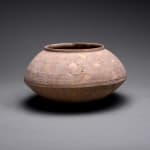Indus Valley Terracotta Vessel, 3300 BCE - 1700 BCE
Terracotta
height 9.5 cm
height 3 3/4 in
height 3 3/4 in
SP.585
The Indus Valley Civilization (c. 3300–1700 BC, flowered 2600–1900 BCE), abbreviated IVC, was an ancient riverine civilization that flourished in the Indus and Ghaggar-Hakra river valleys in what is now...
The Indus Valley Civilization (c. 3300–1700 BC, flowered 2600–1900 BCE), abbreviated IVC, was an ancient riverine civilization that flourished in the Indus and Ghaggar-Hakra river valleys in what is now Pakistan and northwestern India. Another name for this civilization is the Harappan Civilization, after the first excavated city of Harappa. Although IVC might have been known to the Sumerians as Meluhha, the modern world rediscovered it only in the 1920s as a result of archaeological excavations. The IVC is a likely candidate for a Proto-Dravidian culture. Alternatively, Proto-Munda, Proto-Indo-Iranian or a "lost phylum" are somtimes suggested for the language of the IVC (see Substratum in Vedic Sanskrit), The civilization is sometimes referred to as the Indus Ghaggar-Hakra civilization or the Indus-Saraswati civilization. The appellation, Indus-Saraswati is based on the possible identification of the Ghaggar-Hakra River with the ancient Saraswati river of the Rig Veda.



